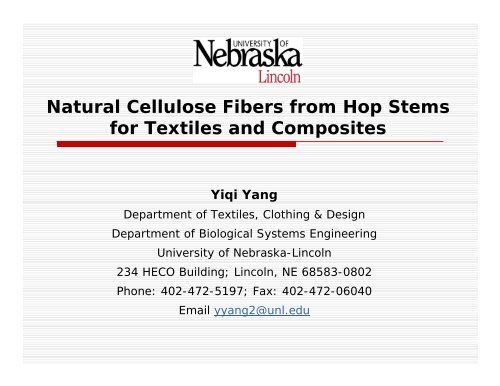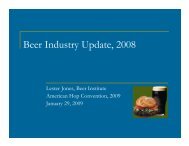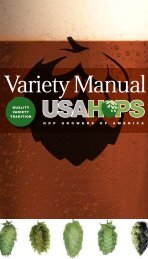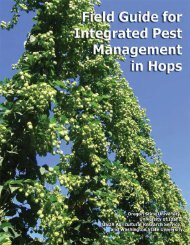Natural Cellulose Fibers from Hop Stems for Textiles and Composites
Natural Cellulose Fibers from Hop Stems for Textiles ... - USA Hops
Natural Cellulose Fibers from Hop Stems for Textiles ... - USA Hops
Create successful ePaper yourself
Turn your PDF publications into a flip-book with our unique Google optimized e-Paper software.
<strong>Natural</strong> <strong>Cellulose</strong> <strong>Fibers</strong> <strong>from</strong> <strong>Hop</strong> <strong>Stems</strong><strong>for</strong> <strong>Textiles</strong> <strong>and</strong> <strong>Composites</strong>Yiqi YangDepartment of <strong>Textiles</strong>, Clothing & DesignDepartment of Biological Systems EngineeringUniversity of Nebraska-Lincoln234 HECO Building; Lincoln, NE 68583-0802Phone: 402-472-5197; Fax: 402-472-06040Email yyang2@unl.edu
Current Textile Market 70 million tons annual consumptionworldwide 13 million tons in the USA (18% of world) 23 million tons of cotton worldwide $600 billion annual textile market in theUSA Second largest industry
Limitations of Current <strong>Fibers</strong> <strong>Natural</strong> <strong>Fibers</strong>• L<strong>and</strong>, water <strong>and</strong> other natural resources• Increase in dem<strong>and</strong>, but decrease in production Synthetic <strong>Fibers</strong>• 55% of total fibers• Non-Renewable petroleum resources• 230 Million barrels of oil in USA• Increase in price
US Cotton Acreage (~1800 lb/acre)14.514.013.513.012.512.011.511.010.510.0Million Acres99 00 01 02 03 04 05 06 07*
Chinese Raw Cotton Needs (500 lb/bale)Cotton Use Minus Production20Million bales1816141210864202000 2001 2002 2003 2004 2005 2006
Advantages of Nontraditional Biofibers<strong>from</strong> Agricultural By-ProductsEconomics• Low cost• High value addition• Large availability• Food <strong>and</strong> fiber <strong>from</strong> same sourcesEnvironment• No additional water• Save energy• Sustainable fiber sourceFiber industry• High quality <strong>and</strong> low cost cellulose fibers
Sources <strong>for</strong> Non-Traditional Biofibers<strong>Cellulose</strong> Protein SyntheticsAgriculturalbyproducts- (<strong>Hop</strong>, cornstover,ricestraw, wheat straw)Other renewableresources- (Switchgrass, velvetleaves)Cereal proteins- (Wheat gluten,soyproteins, cornproteins)Animal proteins- (Feathers, casein,collagen)Genetic engineering- (“Spider” silk)Renewable resources- (PLA, PTT, PHA)
Worldwide Availability of Raw Materials <strong>and</strong>Potential Nontraditional <strong>Cellulose</strong> <strong>Fibers</strong>Raw MaterialAvailability, Million TonsRice strawWheat strawCornstalkCornhuskSoybean strawSorghumPineapple leafSugarcane rindHOPTotalSource580570320642145923329?2069Fiber11611464134312233?388+The potential fiber availability has been calculated based on 20% yield of fibers(10% <strong>for</strong> pineapple leaf fibers <strong>and</strong> sugarcane rind fibers)
Nontraditional BiofiberInitiatives at
Nontraditional BiofiberInnovation at UNLAgricultural Byproducts<strong>Cellulose</strong> <strong>Fibers</strong>- Corn stover-Soybean straw- Wheat straw-Rice straw- Sorghum stalk- HOPProtein <strong>Fibers</strong>- Soyprotein- Wheat gluten- Corn zein- Feathers
Applications of the Non-Traditional <strong>Cellulose</strong> <strong>Fibers</strong> <strong>Textiles</strong>• Apparel• Carpet <strong>Composites</strong>• Automotives• Constructions Filters• Industry• Home
Fiber ProcessingRaw <strong>Fibers</strong> Bleached <strong>Fibers</strong> Dyed <strong>Fibers</strong>
Developing <strong>Textiles</strong>Cornhusk/Cotton yarnsCornhusk/Cotton Garment
Developing Automotive <strong>Composites</strong>Package Tray Cargo Liner HeadlinerSeat Structure Door PanelDashboardHood Liner Trunk Liner
Properties of Alternative <strong>Fibers</strong>FiberLengthTenacityElongationModuluscm(g/den)(%)(g/den)<strong>Hop</strong>6.5-174.7 ± 2.03.6 ± 1.1166Rice2.5-8.03.2-7.31.5-3.8200Cornstalk1.5-8.51.5-4.51.1-3.5127Cornhusk2-202.0-3.010.0-18.070Switchgrass5-72.7-5.52.2-6.870-240Cotton1.5-5.52.7-3.56.0-9.055Linen1.7-175.82.0-3.0203
Automobile HeadlinerComposite PropertiesCompositeOptimized Flexural PropertiesStrengthStiffnessToughness(N)(N/mm)(%)Cornhusk fiber-PP23.32.78168Jute-PP22.45.16115
<strong>Fibers</strong> <strong>from</strong> <strong>Hop</strong> <strong>Stems</strong> Advantages• Byproduct with limited use• High quality fibers• Potential <strong>for</strong> textile <strong>and</strong> composites Economics• Fiber production cost per lb: $0.35-$0.50• Fiber selling price per lb: $1.50-$2.00• Potential sale value per MT: $3.3-$4.4 billion• Potential value addition per MT: $2.5-$3.3 billion
Future Research Develop fiber extraction conditions Determine structure <strong>and</strong> properties ofthe fibers Evaluate the processability as textilefibers Develop textile products Develop automotive composites
Conclusions <strong>Hop</strong> stems <strong>for</strong> fibers• Large availability, low cost• Sustainable <strong>and</strong> renewable resource• High quality fibers• Suitable <strong>for</strong> textile <strong>and</strong> composites• High value addition• Benefit growers, fiber industry <strong>and</strong>environment
Thank You








